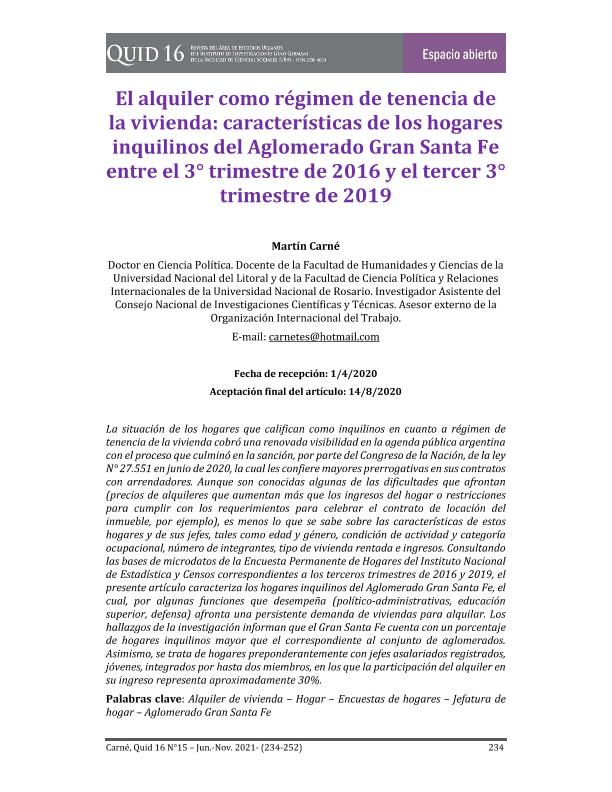Artículo
La situación de los hogares que califican como inquilinos en cuanto a régimen de tenencia de la vivienda cobró una renovada visibilidad en la agenda pública argentina a fines de 2019 cuando la Cámara de Diputados de la Nación dio media sanción al proyecto de ley que les confiere mayores prerrogativas en sus contratos con arrendadores. Aunque son conocidas algunas de las dificultades que afrontan (precios de alquileres que aumentan más que los ingresos del hogar o restricciones para cumplir con los requerimientos para celebrar el contrato de locación del inmueble, por ejemplo), es menos lo que se sabe sobre las características de estos hogares y de sus jefes, tales como edad y género, condición de actividad y categoría ocupacional, número de integrantes, tipo de vivienda rentada e ingresos. Consultando las bases de microdatos de la Encuesta Permanente de Hogares del Instituto Nacional de Estadística y Censos correspondientes a los terceros trimestres de 2016 y 2019, el presente artículo caracteriza los hogares inquilinos del Aglomerado Gran Santa Fe, el cual, por algunas funciones que desempeña (político-administrativas, educación superior, defensa) afronta una persistente demanda de viviendas para alquilar. Los hallazgos de la investigación informan que el Gran Santa Fe cuenta con un porcentaje de hogares inquilinos mayor que el correspondiente al conjunto de aglomerados. Asimismo, se trata de hogares preponderantemente con jefes asalariados registrados, jóvenes, integrados por hasta dos miembros, en los que la participación del alquiler en su ingreso representa aproximadamente 30%. The situation of the households that qualify as tenants in terms of the housing tenure regime was installed again on the Argentine public agenda with the process that culminated in the sanction, by the National Congress, of the law 27.551 in June 2020, which confers greater prerogatives in their contracts with lessors. Although some of the difficulties they face are known (rental prices increasing more than the income of the household or restrictions to meet the requirements to enter into the property lease contract, for example), little is known about the characteristics of these households and of their heads, such as age and gender, activity condition and occupational category, number of members that comprise them, type of rented housing and income. Consulting the microdata bases of the Permanent Household Survey of the National Institute of Statistics and Censuses corresponding to the third quarters of 2016 and 2019, this article characterizes the tenant households of the Gran Santa Fe Agglomerate, which, for some functions it performs (political-administrative, higher education, defense) faces a persistent demand for rental housing. The research findings report that Gran Santa Fe has a higher percentage of tenant households than that corresponding to the group of agglomerates. Likewise, these are households predominantly with young registered salaried heads, made up of up to two members, in which the participation of the rent in their income represents approximately 30%.
El alquiler como régimen de tenencia de la vivienda: características de los hogares inquilinos del Aglomerado Gran Santa Fe entre el 3° trimestre de 2016 y el tercer 3° trimestre de 2019
Título:
Rent as a housing tenure regime: characteristics of the tenant households of the Gran Santa Fe Agglomerate between the 3rd quarter of 2016 and the 3rd quarter of 2019
Fecha de publicación:
07/2021
Editorial:
Universidad de Buenos Aires. Facultad de Ciencias Sociales. Instituto de Investigaciones Gino Germani
Revista:
Quid 16
ISSN:
2250-4060
Idioma:
Español
Tipo de recurso:
Artículo publicado
Clasificación temática:
Resumen
Archivos asociados
Licencia
Identificadores
Colecciones
Articulos(IHUCSO LITORAL)
Articulos de INSTITUTO DE HUMANIDADES Y CIENCIAS SOCIALES DEL LITORAL
Articulos de INSTITUTO DE HUMANIDADES Y CIENCIAS SOCIALES DEL LITORAL
Citación
Carné, Martín Alberto; El alquiler como régimen de tenencia de la vivienda: características de los hogares inquilinos del Aglomerado Gran Santa Fe entre el 3° trimestre de 2016 y el tercer 3° trimestre de 2019; Universidad de Buenos Aires. Facultad de Ciencias Sociales. Instituto de Investigaciones Gino Germani; Quid 16; 15; 7-2021; 234-252
Compartir




